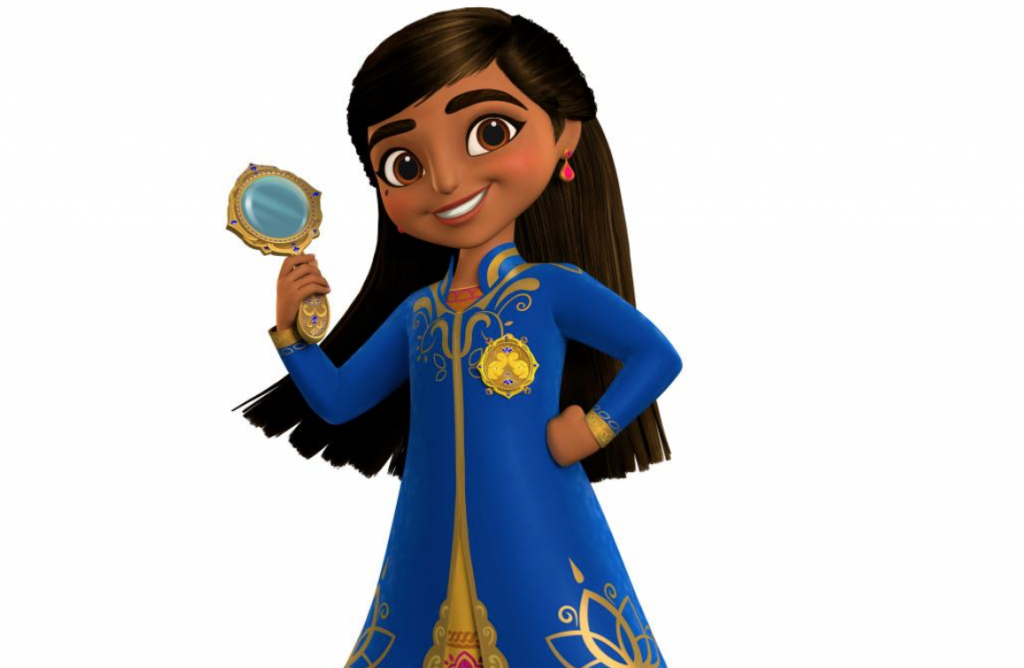Yesterday, Disney announced a new show for their junior network, slated for release in 2020. The show is called “Mira, Royal Detective” and is about the adventures of a smart young girl named Mira in the kingdom of Jalpur. Though a commoner, her ability to solve mysteries for both members of the royal household and common people in the kingdom has earned her the title of Royal Detective. Each episode will feature two 11-minute stories about Mira and her merry band of mates. The show also features “authentic music, dance, and customs that are rooted in India’s vibrant heritage.”
“Mira, Royal Detective” is set to debut on Disney’s Juniors channel in 2020, and we can barely contain our excitement. If the possibility of baby desi Sherlock Holmes is not enticing enough for you, take a peek at the star-studded cast.
Leela Ladnier
https://www.instagram.com/p/BqwT4NQhiog/?utm_source=ig_web_copy_link
This 15-year-old newcomer is all set to make her Disney (and social media) debut as the lead of the new series. She’ll be voicing the title character in “Mira, Royal Detective,” the young, sleuthing star of the show.
Kamran Lucas
https://www.instagram.com/p/BTjeO6PgXvV/
Kamran’s been on the Disney roster since 2016, starring on “Mech-X4.” Now, he’s all set to star as Prince Neel, Mira’s best friend, and a talented inventor at that.
Roshni Edwards
https://www.instagram.com/p/BmgWCrdDali/
This 19-year-old newcomer stays stunting on IG (no, really, follow her and cry with us about how cool she is), and soon she’ll be voicing Priya, Mira’s artsy cousin.
Kal Penn
https://www.instagram.com/p/BqyPlyig5Sx/
Now that he’s had a break from “Harold and Kumar,” and working for Obama, and playing a speechwriter on “Designated Survivor,” and generally being a star on Twitter (seriously what can’t the man do???), Penn will lend some comedic voice acting to “Mira, Royal Detective” by playing a Mongoose name Mikku.
Utkarsh Ambudkar
https://www.instagram.com/p/Bqz_ljxnIGg/
BG’s favorite brown boy (We all know it’s true — we’ve been stans since day one) will join pal Kal Penn as the other mongoose, Chikku.
Frieda Pinto
https://www.instagram.com/p/BnXlQHpHVw6/
Okay, is no one else shook about this??? Pinto will voice Queen Shanti, Mira’s mother, and we cannot wait to watch her character in action.
Hannah Simone
https://www.instagram.com/p/BqYLXy1D9ya/
That’s right people. Disney also managed to rope the best character on “New Girl,” Cece (seriously, I’ll fight anyone on this), into the gang! Simone will voice a young girl named Pinky, and if that isn’t the most desi thing you’ve ever heard, you’re insane.
Jameela Jamil
https://www.instagram.com/p/BqPzkebF7Ak/
The “Mira, Royal Detective” cast would be incomplete without our new best friend, Jameela Jamil, of “The Good Place” fame. As she shared in a super sweet post on Twitter, she’ll be joining the cast to lend her voice as Mira’s Auntie Pushpa.
Aasif Mandvi
https://www.instagram.com/p/BpkIuBCHD1T/
You’ve seen the man in about a million things and he’s a fan favorite here at Brown Girl. Mandvi will play Mira’s father Sahil, and we’re ready for dad jokes and lectures about ‘when I was a young boy…’
Sarita Choudhury
https://www.instagram.com/p/BpN0dfXnr3L/
Whether it’s “Mississippi Masala,” “Homeland” or more, Choudhury doesn’t do anything short of greatness. She’ll be voicing Prince Neel’s Great Aunt Rupa.
Aparna Nancherla
https://www.instagram.com/p/Bl35RqFhR7O/
She was great on “BoJack Horseman,” she’s iconic on Twitter and she’s written for about a billion great shows. Now get ready for her to play Meena, another one of Mira’s cousins, and part of the sleuthing squad.
Karan Brar
https://www.instagram.com/p/Bqlsa62DF9A/
Our boy Ravi’s all grown up!! In case you’re missing Karan from his “Jessie” and “BUNK’D” days, he’s rejoining the Disney crew to voice Prince Veer.
Karan Soni
https://www.instagram.com/p/BpnmCu8hv2m/
Disney really cast this show with South Asian actors from all genres, and we’re super appreciative! Karan Soni gets a double role (hello Bollywood, he’s ready now) on “Mira, Royal Detective,” as twins Ranjeet and Manjeet.
Sarayu Blue
https://www.instagram.com/p/Bpn4YEoAK4Z/
In case you were wondering, YES we absolutely are dying about this too! Sarayu will play a secondary role in the cast, appearing occasionally as the royal tailor.
Parvesh Cheena and Sonal Shah will also feature in a limited number of episodes as bandits Manish and Poonam.
Announcement: If anyone in the world at all needs babysitters after 2020 I gotchu. Your kids are I are gonna have some great “Mira, Royal Detective” marathons.
Oh, and I’m set with my niece’s Christmas/Birthday/just-because-you’re-cute gifts for the next three years, at least. My guess is most South Asian kids will be getting “Mira, Royal Detective” gifts for the next several years, and it’s about time kids see more images that look like them as they grow up.





